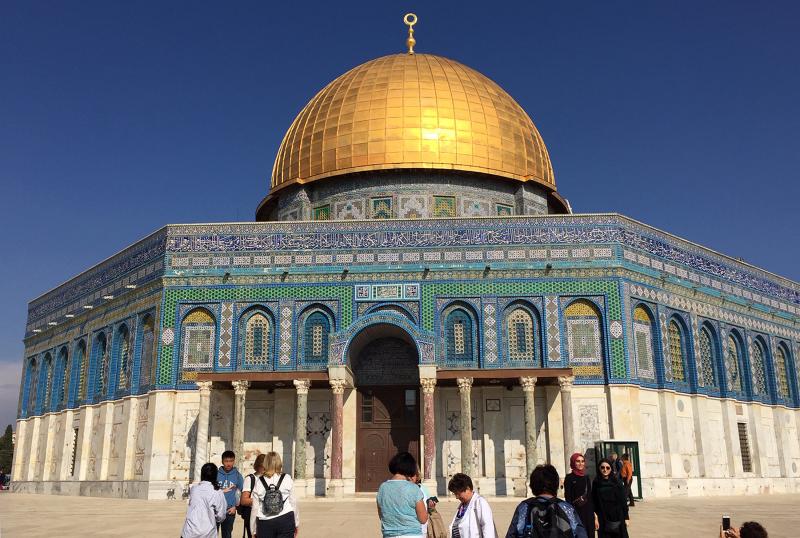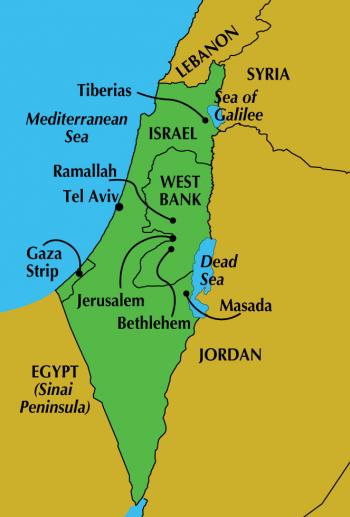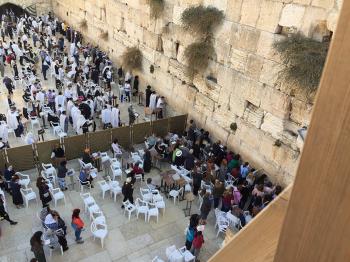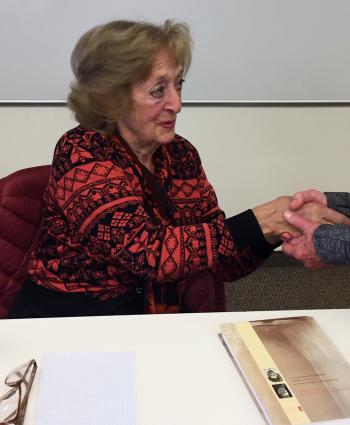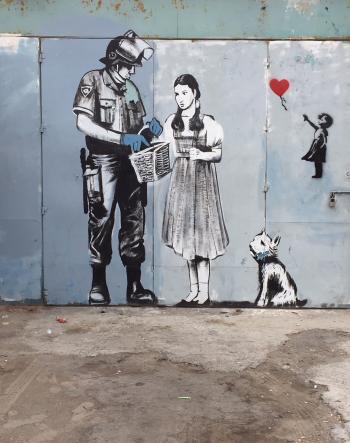A compelling look, from two perspectives, at Israel’s complex history and life there today
This article appears on page 6 of the September 2021 issue.
Like you, I love to travel (though I’m still a bit of a novice by some ITN readers’ standards, having visited only six continents and 60-plus countries). I’ve always viewed travel as a combination of entertainment and education, but my trip to Israel in November 2018 far exceeded my expectations and has had two lasting impacts that I didn’t expect.
The tour
My tour, “The Holy Land: Past, Present, and Future,” was offered by National Geographic Expeditions (Washington, DC; 888/966-8687, nationalgeographic.com/expeditions). What attracted me to that particular tour was the dual narrative it offered, as the tour would have two guides throughout, one a Jewish Israeli, Oded Mandel, and the other a Palestinian, Aziz Abu Sarah. The opportunity to “see” the country through their two sets of eyes was irresistible to me.
Our guides were good friends and interacted respectfully, but they were willing to share their differing perspectives when it added to our understanding of a site.
The tour itself hit many highlights of the country. Although I flew into Tel Aviv, I was met by a representative who quickly got me through Customs and Immigration and then drove me to Jerusalem. I chose to arrive a day early so I would have some time in Jerusalem on my own (and to be sure my air connections all worked).
The tour hotel, The American Colony, was only a few blocks from the Damascus Gate, one of the entrances into the Old City. I had a wonderful day wandering through the kaleidoscope of sights and smells — stalls offering fragrant spices; scarfs; bags; clothing of all kinds and sizes; shoes; T-shirts for tourists; jewelry; small appliances; open bins of candies; meat hanging on hooks; fish in tubs on the ground, and lots of fruit, including huge pomegranates and dates.
I saw two different groups of pilgrims, each carrying a cross about 4 to 5 feet long through the Stations of the Cross, all while softly singing or chanting.
The Old City is a maze, but good signage allows visitors to find their way back to the gates leading out.
I highly recommend scheduling a day on your own, since the tour introduces certain sites within the Old City but doesn’t allow enough time to fully experience them.
Seeing both sides
Our group of 24 began the first day of the tour with a visit to the Temple Mount and the Dome of the Rock, where we met with an imam who explained the significance of the site to Muslims. Afterward we went to the Western Wall, where we had an opportunity to leave our own messages — a moving experience for tour members of all faiths.
During lunch, we met with a Palestinian Christian who shared his perspective and the history of Christians in Israel.
From there, we visited the Church of the Holy Sepulchre, where Jesus is said to have risen after his crucifixion.
In the late afternoon, we met with a Jewish rabbi at our hotel who spoke of the current conflicts and efforts toward peace. By the end of the day, I was overwhelmed with the significance of the sites we had visited and the people we had met.
The next day, we were met at our hotel by a former lieutenant colonel in the Israel Defense Forces who’d served as an intelligence officer. He shared his thoughts on the Jewish claim to the land in Israel and the history of Jewish interactions with Arabs over the last 2,000 years.
Later in the morning we toured the City of David, an extensive archaeological site just outside the walls of the Old City that seems to support writings from biblical times.
Following that exploration, we went through an Israeli checkpoint to Ramallah in the West Bank. I was surprised by the very tall block wall topped by concertina wire that’s designed to keep the Palestinians separated from the rest of Israel.
Signage indicates that entry by Israeli citizens is forbidden, is dangerous to their lives and is against Israeli law. Palestinian residents need an Israeli government permit to exit the area.
In Ramallah, we were addressed by a Palestinian official in the Ministry of Foreign Affairs. Her remarks were sobering and offered a very different perspective than the one I had of Israel, having grown up in America.
By the third day, my fellow tour members and I were trying to sort out and understand the various perspectives we had been exposed to over the previous two days. The complexity of the situation is hard to fathom without being there. And that day’s activities only increased our disorientation as we visited Yad Vashem and the Holocaust History Museum in Jerusalem.
This museum is extremely well done, and I found our visit to be a very emotional experience, though I have visited other such museums and sites in Europe.
Particularly poignant was the Children’s Memorial. Visitors follow a walkway in near darkness, lit only by the seemingly infinite pinpoints of reflected candlelight, representing the approximately 1.5 million children killed during the Holocaust.
After our visit, we spoke with a Holocaust survivor who shared her personal struggle to survive during World War II.
Expanding horizons
When our guide asked if anyone was interested in seeing some nearby Chagall windows, several of us joined him for a walk to a nearby shopping arcade and the location of Hadassah Medical Center. Inside the medical center was a large room lined with spectacular windows. I had seen windows designed by Chagall in Europe, but these were much larger and much more brightly colored.
That evening we met with two representatives from the Parents Circle-Families Forum. Both were fathers who had lost a daughter to the conflict, one Jewish and the other Palestinian. Each shared his transition from pain, anger and a desire for revenge to an understanding that violence only begets violence. Now they work together, sharing their experiences and beliefs as part of this forum of over 600 families who have also lost loved ones in this conflict.
One of the comments that stuck with me the most was that many Palestinians do not know or believe that the Holocaust actually happened. Because of the isolation of the two groups, neither has been exposed to the realities on the other side.
Palestinians who are willing and able to visit Yad Vashem and interact with Jewish people other than soldiers stand to gain a different understanding. Similarly, Israelis who visit the West Bank and get to know Palestinians as people often learn that both sides are victims of oppression.
Our final day in Jerusalem started with a visit to Efrat, one of the Israeli settlements within the Palestinian area, located 10 minutes from Jerusalem. There we met with the mayor of the village, who explained his view of how the settlements have benefited both the settlers and the Palestinian residents.
Next we walked through a refugee camp and studied the graffiti painted on the exterior walls. It would have taken more time than we had to read and study it all, though some was quite artistic, clever and moving.
From there we continued to Bethlehem, which I hadn’t realized was in the West Bank. The Church of the Nativity, built on the location where Jesus is thought to have been born, was very crowded but also very impressive. For the Christians among us, it was definitely a highlight of the tour.
That evening, our tour group was treated to dinner in our Palestinian guide’s traditional family home. Although the family actually lives elsewhere in Jerusalem, they continue to use this home periodically for special events, which includes serving dinner to travelers when our guide is working.
Prepared by his mother and sister-in-law, the food was delicious, and the camaraderie was compelling. After dinner, we were treated to music and dancing provided by a local Israeli-Palestinian group, who played traditional Arabic music as well as songs in Hebrew.
Seeing the sights
Our next museum visit was to the Israel Museum, where the Dead Sea Scrolls are on display. The museum was much too large to see it all in one day, with collections covering prehistoric to present times in archaeology and culture, including both permanent and temporary displays.
From there, we drove to Jericho and the Dead Sea, where we had the opportunity to go into the water (a unique experience) and take pictures as we wished. Then we continued on to the Ein Gedi Hotel, at a kibbutz nearby, for an overnight. A resident there who spoke with us said that, while the kibbutz used to be a commune, now it is simply a consolidation of like-minded people sharing the tasks of daily living but often working outside the kibbutz.
Our hotel had a fabulous kosher buffet, both for dinner and at breakfast the next morning.
The following day we visited Masada, a monumental fortress built high on a mountain by Herod the Great. There is a cable car to take visitors up to the site, though the hearty can choose to walk up, time permitting.
Later in the day we toured Beit She’an, a major archaeological site still being excavated. One of the unusual rooms there was a community toilet, with slabs of limestone around 15 inches wide extending from the walls at chair-seat height, with 5- to 10-inch gaps between the slabs. In Roman times, water ran constantly in a trough below the slabs, flushing out the area continuously.
After an overnight in Tiberias at The Scots Hotel, we visited Capernaum, another large archaeological site, once an old fishing village. Two synagogues have been uncovered there, one on top of the other. Next, a hike to a lovely waterfall was followed by lunch at an outdoor fish restaurant.
In the afternoon we boarded a “Jesus boat” and sailed on the Sea of Galilee. The boats are designed as replicas of the ones which would have been used 2,000 years ago, though these have motors! It is a beautiful area and offered a peaceful respite from our active tour.
On to Nazareth
Checking out of our hotel, our group traveled to Nazareth, where we visited the Basilica of the Annunciation. Tradition says that this is the place where Mary was approached by the angel Gabriel. Several countries have commissioned large panels to adorn its walls, all of which were lovely.
Later, a Palestinian Arab, a citizen of the State of Israel, came on the bus to speak with us about his experiences as an Israeli citizen with limited rights because he’s an Arab. As a citizen under the United Nations’ 1948 resolution creating Israel and a citizen prior to the Six-Day War in 1967, he is still limited in where he can travel in Israel today. The rules are incredibly complex, with the apparent intent to keep the Jews and the Arabs separated.
After lunch with a Druze family to learn about their faith and customs, we had a quick tour of Jaffa before heading on to Tel Aviv. There was time to explore this lovely city on our own, with its skyscrapers and excellent restaurants. It’s hard to believe that Jerusalem, which seems right out of biblical times, and Tel Aviv, which is state of the art and modern by design, are only about an hour apart. What a contrast!
On our final day, we visited Caesarea Maritima and met with a geoarchaeologist/marine archaeologist working with National Geographic to explore ancient sites that are near or under water. She led us on a tour of what has been discovered so far and explained the significance of some of the findings.
Final impressions
So what were the two lasting impacts of this experience for me?
First, after arriving back in the US and over the course of the last two years, I have become much more involved in following news events about Israel and learning more about the different perspectives. I can’t believe how little I really knew about that country.
Much of what our media produces is, at best, incomplete and, at worst, very biased in one direction or the other. And it ignores the Christians and other ethnic groups who are caught up in the conflict. The entire Israeli-Palestinian situation is incredibly complex and can’t be covered in 30-second sound bites.
The impact of the sites we visited and the people we spoke with has not left me. I have discovered books at my local library and websites that continue to expand my knowledge and deepen my understanding of the complexity of the current situation.
The second impact will have long-range effects. This tour has convinced me that travel has to be more than just visiting famous sites. Without interacting with locals and making a point to get off the beaten path, we travelers get an incomplete perspective of the countries we visit. We don’t learn about the impact of tourism on the area, both good and bad, and we don’t learn much about the daily lives of the people we see everywhere.
I’ve been on tours where we see the sites and then are taken back to our hotel away from the city center “to rest.” With a little effort, you can get much more out of a tour.
Choose your next tour company carefully, and find out the details of the tour itinerary, not just the sights you will see. (After returning home, I learned that the tour was actually operated by Mejdi Tours, which specializes in dual-narrative tours to various destinations. Our Palestinian guide is a cofounder of that company.)
While you are in another country, strike up a conversation with the people you encounter, if at all possible. Make a point to explore what happens to the people you meet when the day ends. Where do they live? What do they do for fun? How do they view the US? I guarantee you will have a richer experience, wherever you travel.
This 11-day tour is currently scheduled for both this year and 2022, with departures beginning in October 2021. The cost is $6,995 per person, double ($9,390, single), not including international airfare.

